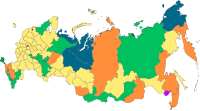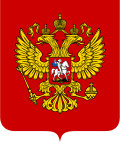كيانات روسيا الاتحادية
| كيانات روسيا الاتحادية | |
|---|---|
 | |
| نوع التقسيم | فدرالية (توجه سياسي) نظام شبه رئاسي جمهورية |
| الدولة | |
| الإنشاء | 12 December 1993 |
| العدد | 83 |
| السكان | 41,431 (أوكروية نينيتس الذاتية) – 13,010,112 (موسكو) |
| المناطق | 864 كـم2 (334 ميل2) (سيفاستوبول) – 3,103,200 كـم2 (1,198,200 ميل2) (ياقوتيا) |
| الحكومة | Regional government, حكومة روسيا |
| التقسيم الأقل | مناطق |
الكيانات الفيدرالية لروسيا، والتي يشار إليها أيضًا باسم رعايا الاتحاد الروسي (بالروسية: субъекты Российской Федерации) أو رعايا الاتحاد (بالروسية: субъекты федерации) فقط، تشكل التقسيمات الإدارية لروسيا، وهي الانقسامات السياسية عالية المستوى وفقًا لدستور روسيا.[1] الكيان الفدرالي كالينينغراد هو الكيان الفيدرالي الوحيد المنفصل جغرافيًا عن بقية أراضي الاتحاد الروسي بدول أخرى.
وفقًا للدستور الروسي ، يتكون الاتحاد الروسي من جمهوريات ، وكرايس ، وأوبلاستات ، ومدن ذات أهمية اتحادية ، وأوبلاستات ذات حكم ذاتي ، وأوكروغات ذات حكم ذاتي ، وجميعها رعايا متساوية في الاتحاد الروسي. تتمتع ثلاث مدن روسية ذات أهمية فدرالية (موسكو ، وسانت بطرسبرغ ، وسيفاستوبول) بوضع كل من المدينة والموضوع الفيدرالي المنفصل الذي يضم مدنًا وبلدات أخرى ( زيلينوجراد ، وترويتسك ، وكرونشتاد ، وكولبينو ، وما إلى ذلك) داخل كل مدينة اتحادية - مع الحفاظ على تقدم العمر هياكل العناوين البريدية. في عام 1993 ، كان الاتحاد الروسي يضم 89 الموضوعات الفيدرالية. بحلول عام 2008 ، انخفض عدد الموضوعات الفيدرالية إلى 83 بسبب اندماجات عديدة. في عام 2014 بعد ضمها من أوكرانيا ، تم الإعلان عن سيفاستوبول وجمهورية القرم باعتبارهما الرعايا الفيدراليين 84 و 85 لروسيا ، وهي خطوة لم يتم الاعتراف بها دوليًا.[2][3] خلال الغزو الروسي لأوكرانيا عام 2022 ، ضمت روسيا أربع مقاطعات أوكرانية ، على الرغم من أنها لا تزال معترف بها دوليًا كجزء من أوكرانيا ولا تحتلها روسيا إلا جزئيًا.[4]
لكل مقاطعة فيدرالية حاكم وبرلمان ومحكمة دستورية. لكل مقاطهة فيدرالية دستورها أو ميثاقها وتشريعاتها، على الرغم من اختلاف سلطة هذه الأجهزة. يتمتع الأشخاص بحقوق متساوية في العلاقات مع هيئات الحكومة الفيدرالية.[1] تتمتع المقاطعات الفيدرالية بتمثيل متساوٍ - مندوبان لكل منهما - في مجلس الاتحاد، المجلس الأعلى للجمعية الفيدرالية . ومع ذلك ، فإنهم يختلفون في درجة الاستقلالية التي يتمتعون بها ؛ تُمنح الجمهوريات مزيدًا من الاستقلالية.
تشكلت روسيا ما بعد الاتحاد السوفيتي خلال تاريخ جمهورية روسيا الاتحادية الاشتراكية السوفياتية داخل الاتحاد السوفياتي ولم تتغير في وقت تفكك الاتحاد السوفيتي في عام 1991. في عام 1992 ، خلال ما يسمى " موكب السيادات " ، والمشاعر الانفصالية وحرب القوانين داخل روسي ، وقعت المناطق الروسية على معاهدة الاتحاد ( (بالروسية: Федеративный договор) Federativny dogovor ) ، [5] إنشاء وتنظيم التكوين الداخلي الحالي لروسيا ، بناءً على تقسيم السلطات والسلطات بين الهيئات الحكومية الروسية والهيئات الحكومية للكيانات المكونة. أُدرجت معاهدة الاتحاد في نص دستور عام 1978 لجمهورية روسيا الاتحادية الاشتراكية السوفياتية . دخل الدستور الحالي لروسيا ، الذي تم تبنيه في استفتاء عام في 12 ديسمبر 1993 ، حيز التنفيذ في 25 ديسمبر 1993 وألغى نموذج نظام الحكم السوفيتي الذي أدخله فلاديمير لينين في عام 1918 واستند إلى الحق في الانفصال عن البلاد وعلى سيادة غير محدودة للمواطنين الفيدراليين (في الممارسة العملية لم يكن الانفصال مسموحًا به أبدًا) ، الأمر الذي يتعارض مع نزاهة البلاد والقوانين الفيدرالية. قضى الدستور الجديد على عدد من النزاعات القانونية، واحتفظ بحقوق المناطق، وأدخل الحكم الذاتي المحلي ولم يمنح الحق في الحقبة السوفيتية في الانفصال عن البلاد.
في أواخر التسعينيات وأوائل القرن الحادي والعشرين ، أصبح النظام السياسي بحكم القانون أقرب إلى الدول الفيدرالية الحديثة الأخرى ذات الشكل الجمهوري للحكم في العالم. في العقد الأول من القرن الحادي والعشرين ، وفي أعقاب سياسات فلاديمير بوتين وحزب روسيا المتحدة الحاكم ، غيّر البرلمان الروسي توزيع عائدات الضرائب ، وخفض عدد الانتخابات في المناطق ، ومنح المزيد من السلطة للسلطات الفيدرالية.
المصطلح[عدل]
تستخدم الترجمة الحكومية الرسمية لدستور روسيا من الروسية إلى الإنجليزية مصطلح "الكيانات المكونة للاتحاد الروسي". على سبيل المثال: تنص المادة 5 على ما يلي: "يتألف الاتحاد الروسي من جمهوريات وكرايات وأوبلاستات ومدن ذات أهمية اتحادية وأوبلاستات ذات حكم ذاتي وأوكروغات تتمتع بالحكم الذاتي ، والتي يجب أن تتمتع بحقوق متساوية ككيانات مكونة للاتحاد الروسي." [1] تستخدم الترجمة المقدمة من غارانت إنترنت بدلاً من ذلك مصطلح "رعايا الاتحاد الروسي".[6]
أخبر المترجم توم فينيل مؤتمر جمعية المترجمين الأمريكيين لعام 2008 أن "الكيان المكون للاتحاد الروسي" هو ترجمة أفضل من "الكيان".[7] وقد أيدت ذلك تمارا نيكراسوفا ، رئيسة قسم الترجمة في Goltsblat BLP، قائلة في عرض تقديمي عام 2011 في مؤتمر للمترجمين أن " الكيان التأسيسي للاتحاد الروسي أكثر ملاءمة من موضوع الاتحاد الروسي (سيكون الموضوع مناسبًا للنظام الملكي) ".[8]
| الرتبة (على النحو الوارد في الدستور و ISO) | الروسية | حسب الترجمات الإنجليزية للدستور | ISO 3166-2: RU (ISO 3166-2 الرسالة الإخبارية II-2 (2010-06-30)) | ||
|---|---|---|---|---|---|
| (سيريلي) | نقحرة عربية | الرسمية [1] | غير رسمي [6] | ||
| - | субъект Российской Федерации | سيبكت روسيسكوي فيدراتسي | الكيان المكون من الاتحاد الروسي | كيان الاتحاد الروسي | (لم يذكر) |
| 1 | республика | ريبوبليكا | جمهورية
| ||
| 2 | край | كراي
|
إِقلِيم | المنطقة الإدارية | |
| 3 | область | أوبلاست | أوبلاست | منطقة | الإدارية |
| 3 | город федерального значения | غورود فيدرالينوغو زناينيا | مدينة ذات أهمية فيدرالية | مدينة ذات أهمية اتحادية | مدينة مستقلة
(المصطلح الروسي المستخدم في ISO 3166-2 هو автономный город أفتونومني جورود ) |
| 5 | автономная область | أفتونومنايا أوبلاست | الأوبلاست المستقل | منطقة الحكم الذاتي | منطقة الحكم الذاتي |
| 6 | автономный округ | أوكروج أفتونومنيه | أوكروغ مستقلة | منطقة مستقلة | منطقة الحكم الذاتي |
الاندماجات[عدل]

تنتمي الكيانات الاتحادية الروسية لأحد الأنواع الآتية:
| مفتاح الخريطة[2] | وصف |
|---|---|
46 مقاطعة
2 غير معترف بها
|
النوع الأكثر شيوعًا ، مع حاكم ومجلس تشريعي منتخب محليًا. شائع اسمه بعد مراكزهم الإدارية.
أقاليم خيرسون وزابوروجي محتلة جزئيًا وتم ضمها في عام 2022 ولم يُعترف بها دوليًا كأجزاء من روسيا. |
21 جمهوريات
3 غير معترف بها
|
تتمتع باستقلالية اسمية ، [9][10] لكل منها دستورها ولغتها وهيئتها التشريعية الخاصة ، ولكن تمثلها الحكومة الفيدرالية في الشؤون الدولية. معظمهم موطن لأقلية عرقية معينة (أو مجموعة من الأقليات ، في حالتي داغستان وموردوفيا ).
</br> جمهوريتا دونيتسك ولوغانسك محتلة جزئيًا منذ عام 2014 وتم ضمهما في عام 2022 وغير معترف بهما دوليًا كأجزاء من روسيا ؛ تم ضم شبه جزيرة القرم في عام 2014 ولم يتم الاعتراف بها دوليًا كجزء من روسيا. |
| لجميع المقاصد والأغراض ، فإن الكرايات متطابقة قانونًا مع الأوبلاستات. العنوان "كراي" ("حدودي" أو "إقليم") تاريخي مرتبط بالموقع الجغرافي (الحدودي) في فترة معينة من التاريخ. لا ترتبط الكرايس الحالية بالحدود. | |
|
|
يشار إليها أحيانًا باسم "منطقة حكم ذاتي" أو "مقاطعة حكم ذاتي" ولكل منها أقلية عرقية كبيرة أو سائدة. باستثناء شوكوتكا كل من الأوكروغات المستقلة هي جزء من إقليم آخر (أرخانجيلسك وتيومن) ، بالإضافة إلى كيانها الإتحادي الخاص. |
|
1 غير معترف بها
|
المدن الكبرى التي تعمل كمناطق منفصلة. ضُمَّت سيفاستوبول في عام 2014 ولم يُعترف بها دوليًا جزءاً من روسيا. |
|
|
هي المقاطعة اليهودية الذاتية الوحيدة. |
قائمة[عدل]
ملاحظات[عدل]
انظر أيضًا[عدل]
- تقسيمات روسيا
- قائمة مناطق روسيا
- جمهوريات الاتحاد السوفيتي
- أعلام الجمهوريات السوفيتية
- أعلام الأقاليم الروسية
- قائمة الأقاليم الروسية حسب عدد السكان
المراجع[عدل]
- ^ أ ب ت ث "Constitution of the Russian Federation". Government of the Russian Federation. مؤرشف من الأصل في 2023-01-01. اطلع عليه بتاريخ 2022-08-11.
- ^ أ ب Heaney، Dominic، المحرر (2022). "Territorial Surveys". The Territories of the Russian Federation 2022 (ط. 23rd). Abingdon, Oxon: روتليدج (دار نشر). ISBN:9781032249698. مؤرشف من الأصل في 2022-11-11.
- ^ Steve Gutterman and Pavel Polityuk (18 مارس 2014). "Putin signs Crimea treaty as Ukraine serviceman dies in attack". Reuters. مؤرشف من الأصل في 2023-03-26. اطلع عليه بتاريخ 2016-05-07.
- ^ "Putin to annex seized Ukrainian land, U.N. Warns of 'dangerous escalation'". Reuters. 29 سبتمبر 2022. مؤرشف من الأصل في 2022-12-24.
- ^ This treaty consisted of three treaties, see also Concluding and Transitional Provisions:
- ^ أ ب "The Constitution of the Russian Federation". Garant-Internet. مؤرشف من الأصل في 2023-01-08. اطلع عليه بتاريخ 2022-08-11.
- ^ Knizhnik، Irina (2009). "On legal terminology, the jury is still out" (PDF). Slavic Languages Division, American Translators Association. ج. 18 ع. 1: 20. مؤرشف (PDF) من الأصل في 2020-10-31. اطلع عليه بتاريخ 2022-08-11.
- ^ Nekrasova، Tamara (2011). "Traps & Mishaps in Legal Translation" (PDF). Eulita. مؤرشف من الأصل (PDF) في 2023-02-11. اطلع عليه بتاريخ 2022-08-11.
- ^ The Territories of the Russian Federation 2012. Taylor & Francis. 2012. ص. 5. ISBN:978-1-135-09584-0. مؤرشف من الأصل في 2022-10-12. اطلع عليه بتاريخ 2019-10-06.
- ^ Saunders، R.A. (2019). Historical Dictionary of the Russian Federation. Historical Dictionaries of Europe. Rowman & Littlefield Publishers. ص. 232. ISBN:978-1-5381-2048-4. مؤرشف من الأصل في 2022-10-12. اطلع عليه بتاريخ 2019-10-06.
- ^ "Таблица 5. Численность населения России, федеральных округов, субъектов Российской Федерации, городских округов, муниципальных районов, муниципальных округов, городских и сельских поселений, городских населенных пунктов, сельских населенных пунктов с населением 3000 человек и более". Federal Service for State Registration, Cadastre and Cartography. مؤرشف من الأصل في 2021-12-10. اطلع عليه بتاريخ 2019-03-04.
- ^ "Оценка численности постоянного населения по субъектам Российской Федерации". اللجنة الحكومية للإحصاء. مؤرشف من الأصل في 2023-04-22. اطلع عليه بتاريخ 2022-09-01.
- ^ أ ب "Crimea becomes part of vast Southern federal district of Russia". مؤرشف من الأصل في 2023-04-22. اطلع عليه بتاريخ 2016-07-29.
- ^ أ ب "В России создан Крымский федеральный округ". RBC. 21 مارس 2014. مؤرشف من الأصل في 2014-03-22. اطلع عليه بتاريخ 2015-11-18.
- ^ أ ب ت ث Чисельність наявного населення України на 1 січня 2021 / Number of Present Population of Ukraine, as of January 1, 2021 (PDF) (بالأوكرانية والإنجليزية). Kyiv: State Statistics Service of Ukraine. Archived from the original (PDF) on 2023-04-03.
| في كومنز صور وملفات عن: كيانات روسيا الاتحادية |
وسوم <ref> موجودة لمجموعة اسمها "arabic-abajed"، ولكن لم يتم العثور على وسم <references group="arabic-abajed"/> أو هناك وسم </ref> ناقص

